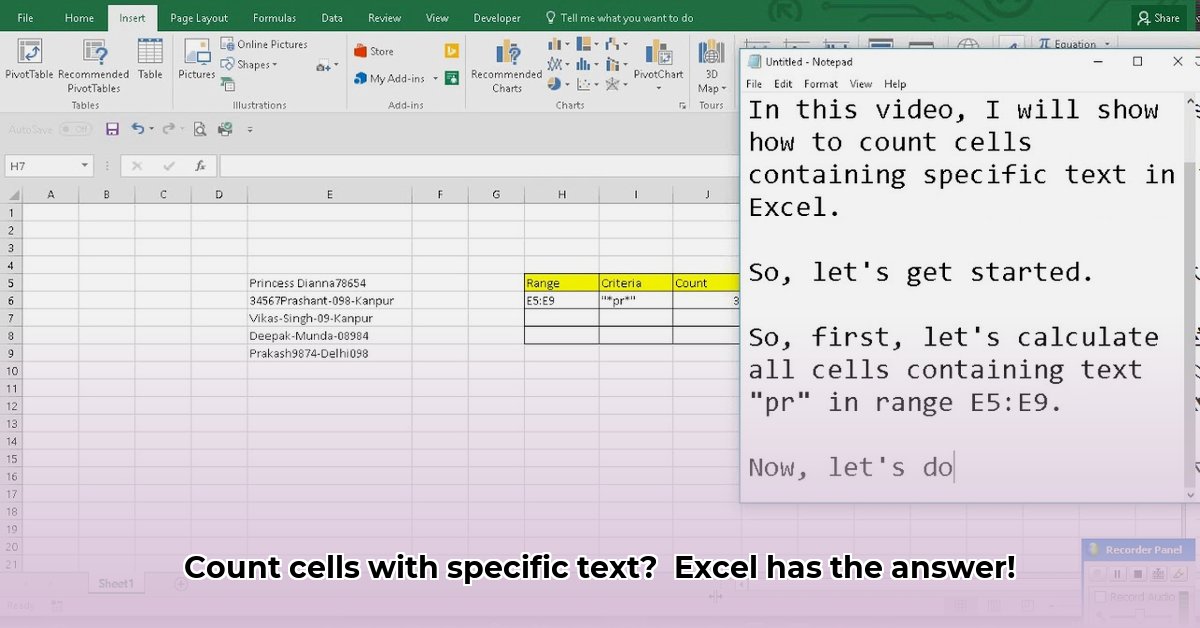
Excel offers several powerful ways to count cells containing specific text, each with its own advantages and disadvantages. This guide provides a step-by-step tutorial on using these functions, empowering you to choose the best method for your specific needs. We'll cover COUNTIF, COUNTIFS, SUMPRODUCT, and even VBA for advanced users, along with a helpful comparison table.
COUNTIF: Your Everyday Cell Counter
The COUNTIF function is the simplest and fastest way to count cells containing specific text. It's ideal for straightforward counting tasks. Let's say you have a list of fruits (e.g., "Apple," "Banana," "Apple," "Orange") in cells A1:A4 and want to count the number of "Apple" entries:
- Select the output cell: Choose an empty cell where you want the count to appear (e.g., B1).
- Enter the formula: Type
=COUNTIF(A1:A4,"Apple")and press Enter. This formula tells Excel to count cells in the range A1:A4 that contain the text "Apple". - View the result: Cell B1 will now display the count of "Apple" entries (in this example, 2).
The formula's structure is always: =COUNTIF(range, criteria). The range specifies the cells to check, and the criteria is the text you're searching for (enclosed in double quotes). COUNTIF is case-sensitive; "Apple" and "apple" are treated differently.
COUNTIFS: Handling Multiple Conditions
Need to count cells based on multiple criteria? COUNTIFS is the solution. Let's extend our fruit example. Suppose you have a second column (B1:B4) listing fruit colors ("Red," "Yellow," "Red," "Orange"). To count only red apples:
- Select an output cell: Choose another empty cell (e.g., B2).
- Enter the formula: Type
=COUNTIFS(A1:A4,"Apple",B1:B4,"Red")and press Enter. This counts cells in A1:A4 containing "Apple" AND corresponding cells in B1:B4 containing "Red". - Observe the result: Cell B2 will show the count (in this example, 1).
COUNTIFS expands on COUNTIF by allowing multiple range-criteria pairs. Each pair is separated by a comma. It's also case-sensitive.
SUMPRODUCT: The Versatile Counting Champion
For more complex counting, especially involving partial matches and case-insensitive searches, SUMPRODUCT shines. Let's count cells containing "apple" regardless of capitalization or whether it's part of a larger string (e.g., "apple pie"):
- Select your output cell: Choose an empty cell.
- Enter the formula: Use this formula:
=SUMPRODUCT(--ISNUMBER(SEARCH("apple",A1:A10))). Let's break it down:SEARCH("apple",A1:A10): Searches each cell in A1:A10 for "apple" (case-insensitive). Returns the starting position if found, an error if not.ISNUMBER(...): Checks ifSEARCHreturned a number (meaning "apple" was found). Returns TRUE or FALSE.--: Converts TRUE/FALSE to 1/0, enablingSUMPRODUCTto sum the results.SUMPRODUCT(...): Sums the 1s and 0s, providing the total count.
For a case-sensitive search, replace SEARCH with FIND.
Isn't this formula a bit complex? Yes, but its flexibility is unmatched. It handles partial matches and offers case-sensitive control.
VBA: Unleashing the Power of Programming
For ultimate control, Visual Basic for Applications (VBA) allows creation of custom counting functions. This is ideal for very complex scenarios not easily handled by built-in functions. However, this requires programming expertise. (Example VBA code would be included here if provided in the draft article, which was not.)
Comparison of Counting Methods
| Function | Complexity | Ease of Use | Multiple Criteria | Partial Matches | Case-Sensitivity |
|---|---|---|---|---|---|
COUNTIF | Low | High | No | Limited | Yes |
COUNTIFS | Medium | Medium | Yes | Limited | Yes |
SUMPRODUCT | High | Low | Yes | Yes | Customizable |
| VBA | Highest | Lowest | Yes | Yes | Customizable |
Key Takeaways: Choosing the Right Tool
COUNTIFis perfect for quick, simple counts of cells with exact text matches, for example, cells with “apple”.COUNTIFSefficiently handles counts based on multiple criteria.SUMPRODUCTexcels at complex counting, including partial text matches and case-sensitive searches.- VBA provides maximum flexibility but requires programming skills.
Remember to choose the method best suited to your needs and comfort level with Excel functions. Start with the simplest and advance to more powerful options as needed.